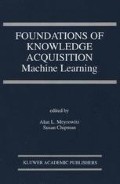Abstract
In this chapter we describe Eureka, a problem solver that uses analogy as its basic reasoning and learning process. Eureka introduces a learning mechanism called analogical search control, and uses a model of memory based on spreading activation to retrieve analogies and solve problems. These relatively simple mechanisms allow the system to account for a number of psychological phenomena in problem solving. In this chapter we focus on some of the computational aspects of the system. To this end, we provide a full description at theoretical and implementation levels, and present the results of some experiments that explore the model’s computational behavior.
Access this chapter
Tax calculation will be finalised at checkout
Purchases are for personal use only
Preview
Unable to display preview. Download preview PDF.
References
Anderson, J. R. (1974). Retrieval of propositional information from long-term memory. Cognitive Psychology, 5, 451–474.
Anderson, J. R. (1976). Language, memory, and thought. Hillsdale, NJ: Lawrence Erlbaum.
Anderson, J. R. (1983). The architecture of cognition. Cambridge, MA: Harvard University Press.
Anderson, J. R. & Thompson, R. (1989). Use of analogy in a production system architecture. In S. Vosniadou & A. Ortony (Eds.), Similarity and analogical reasoning. Cambridge, England: Cambridge University Press.
Carbonell, J. G. (1983). Learning by analogy: Formulating and generalizing plans from past experience. In R. S. Michalski, J. G. Carbonell, & T. M. Mitchell (Eds.), Machine learning: An artificial intelligence approach. Los Altos, CA: Morgan Kaufmann.
Carbonell, J. G. (1986). Derivational analogy: A theory of reconstructive problem solving and expertise acquisition. In R. S. Michalski, J. G. Carbonell, & T. M. Mitchell (Eds.), Machine learning: An artificial intelligence approach (vol. 2). Los Altos, CA: Morgan Kaufmann.
Collins, A., & Quillian, M. R. (1969). Retrieval time from semantic memory. Journal of Verbal Learning and Verbal Behavior, 8, 240–248.
Ernst, G., & Newell, A. (1969). GPS: A case study in generality and problem solving. New York: Academic Press.
Falkenhainer, B. C. (1989). Learning from physical analogies: A study in analogy and the explanation process. Doctoral dissertation, University of Illinois at Urbana-Champaign.
Falkenhainer, B., Forbus, K. D., & Gentner, D. (1986). The structure-mapping engine. Proceedings of the Fifth National Conference on Artificial Intelligence (pp. 272–277). Philadelphia: Morgan Kaufmann.
Fikes, R. E., & Nilsson, N. J. (1971). STRIPS: A new approach to the application of theorem proving to problem solving. Artificial Intelligence, 2, 189–208.
Gentner, D. (1983). Structure-mapping: A theoretical framework for analogy. Cognitive Science, 7, 155–170.
Hall, R. P. (1989). Computational approaches to analogical reasoning: A comparative analysis. Artificial Intelligence, 39, 39–120.
Hammond, K. J. (1988). Case-based planning: An integrated theory of planning, learning, and memory (Doctoral dissertation, Yale University, 1986). Dissertation Abstracts International, 48, 3025B.
Holland, J. H., Holyoak, K. J., Nisbett, R. E., & Thagard, P. R. (1986). Induction: Processes of inference, learning, and discovery. Cambridge, MA: MIT Press.
Holyoak, K. J., & Koh, K. (1987). Surface and structural similarity in analogical transfer. Memory and Cognition, 15, 332–340.
Holyoak, K. J., & Thagard, P. (1989). Analogical mapping by constraint satisfaction. Cognitive Science, 13, 295–355.
Jones, R. M. (1989). A model of retrieval in problem solving. Doctoral dissertation, University of California, Irvine.
Jones, R. M. & Langley, P. (1991). An integrated model of retrieval and problem solving. Manuscript submitted for publication.
Jones, R. M. & VanLehn, K. (1991). Strategy shifts without impasses: A computational model of the sum-to-min transition. In Proceedings of the Thirteenth Annual Conference of the Cognitive Science Society (pp. 358–363). Chicago: Lawrence Erlbaum.
Kolodner, J. L., Simpson, R. L., & Sycara, K. (1985). A process model of case-based reasoning in problem solving. In Proceedings of the Ninth International Joint Conference on Artificial Intelligence (pp. 284–290). Los Angeles: Morgan Kaufmann.
Laird, J. E., Rosenbloom, P. S., & Newell, A. (1986a). Chunking in Soar: The anatomy of a general learning mechanism. Machine Learning, 1, 11–46.
Laird, J. E., Rosenbloom, P. S., & Newell, A. (1986b). Universal sub-goaling and chunking: The automatic generation and learning of goal hierarchies. Hingham, MA: Kluwer Academic.
Langley, P. (1985). Learning to search: From weak methods to domain-specific heuristics. Cognitive Science, 9, 217–260.
Langley, P., & Allen, J. A. (1991). The acquisition of human planning expertise. In L. A. Birnbaum & G. C. Collins (Eds.), Machine Learning: Proceedings of the Eighth International Workshop (pp. 80–84). Evanston, IL: Morgan Kaufmann.
Meyer, D. E., & Schvaneveldt, R. W. (1971). Facilitation in recognizing pairs of words: Evidence of a dependence between retrieval operations. Journal of Experimental Psychology, 90, 227–234.
Minton, S. (1989). Learning effective search control knowledge: An explanation-based approach (Doctoral dissertation, Carnegie Mellon University, 1988). Dissertation Abstracts International, 49, 4906B–4907B.
Mitchell, T. M, Utgoff, P. E., & Banerji, R. (1983). Learning by experimentation: Acquiring and refining problem-solving heuristics. In R. S. Michalski, J. G. Carbonell, T. M. Mitchell (Eds.), Machine learning: An artificial intelligence approach. Los Altos, CA: Morgan Kaufmann.
Neches, R. (1982). Models of heuristic procedure modification (Doctoral dissertation, Carnegie Mellon University, 1981). Dissertation Abstracts International, 43, 1645B.
Ohlsson, S. (1987). Transfer of training in procedural learning: A matter of conjectures and refutations? In L. Bole (Ed.), Computational models of learning. Berlin: Springer-Verlag.
Schank, R. C. (1982). Dynamic memory. Cambridge, England: Cambridge University Press.
VanLehn, K., & Jones, R. M. (in press). Integration of explanation-based learning of correctness and analogical search control. In S. Minton & P. Langley (Eds.), Proceedings of the symposium on learning, planning and scheduling. Los Altos, CA: Morgan Kaufmann.
Author information
Authors and Affiliations
Editor information
Editors and Affiliations
Rights and permissions
Copyright information
© 1993 Kluwer Academic Publishers
About this chapter
Cite this chapter
Jones, R. (1993). Problem Solving via Analogical Retrieval and Analogical Search Control. In: Meyrowitz, A.L., Chipman, S. (eds) Foundations of Knowledge Acquisition. The Springer International Series in Engineering and Computer Science, vol 195. Springer, Boston, MA. https://doi.org/10.1007/978-0-585-27366-2_7
Download citation
DOI: https://doi.org/10.1007/978-0-585-27366-2_7
Publisher Name: Springer, Boston, MA
Print ISBN: 978-0-7923-9278-1
Online ISBN: 978-0-585-27366-2
eBook Packages: Springer Book Archive

